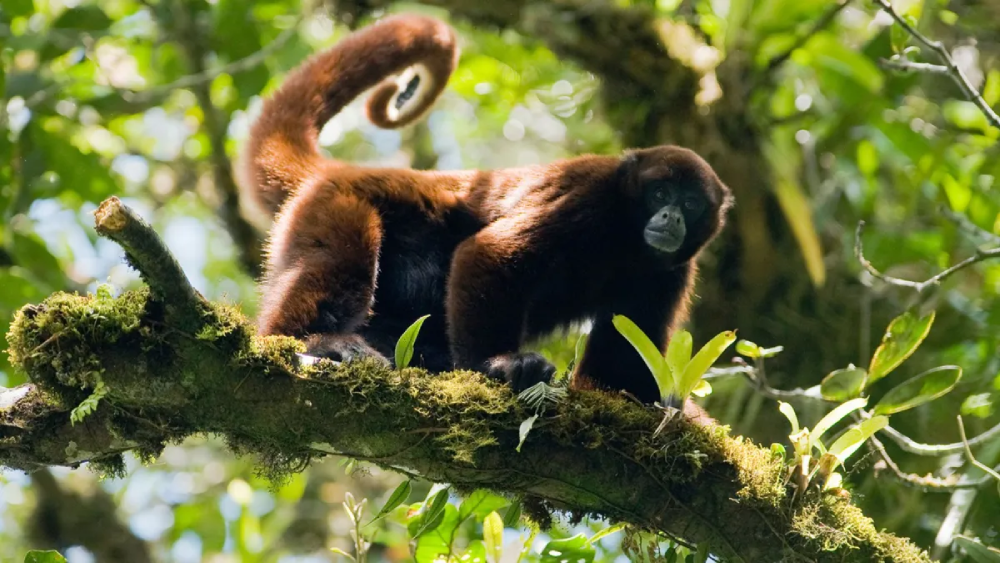The Peruvian Yellow-tailed Woolly Monkey, known scientifically as *Oreonax flavicauda*, is one of the world’s most elusive and endangered primates. This species is endemic to the cloud forests of the Andes in northern Peru, inhabiting a narrow range within the departments of Amazonas and San Martín. Characterized by its distinctive yellow tail and woolly fur, this monkey plays a crucial role in its ecosystem but faces significant threats that challenge its survival.
Physical Characteristics of the Peruvian Yellow-tailed Woolly Monkey
The Yellow-tailed Woolly Monkey is distinguished by its dense, woolly fur which is primarily a reddish-brown color. Its most striking feature is its tail. That is not only prehensile but also has a unique yellow underside that serves as an identification marker. Adult males typically weigh between 9 and 15 kilograms, while females are slightly smaller. Their expressive faces are framed by tufts of hair, and they possess strong limbs adapted for an arboreal lifestyle.

Habitat and Distribution of Peruvian Yellow-tailed Woolly Monkey
These primates are found in the montane cloud forests of the Andes, at elevations ranging from 1,500 to 2,700 meters above sea level. These forests are characterized by high humidity, frequent mist, and diverse vegetation, providing an ideal environment for the Yellow-tailed Woolly Monkey. The dense canopy offers ample food resources and protection from predators. However, this habitat is fragmented and limited, increasing the species’ vulnerability.
Behavior and Diet
The Yellow-tailed Woolly Monkey is arboreal and primarily frugivorous, feeding on a variety of fruits, leaves, flowers, and occasionally small invertebrates. They live in social groups that can vary in size but often include several males, females, and their offspring. These groups are highly social, engaging in grooming and vocal communication to maintain bonds and coordinate movements.
Their day is typically divided between foraging and resting, with foraging taking up the majority of their activity. The monkeys are known for their acrobatic prowess, often seen leaping from tree to tree with their prehensile tails providing balance and support.
Conservation Status
The International Union for Conservation of Nature (IUCN) classifies the Yellow-tailed Woolly Monkey as Critically Endangered. The primary threats to their survival include habitat destruction, hunting, and climate change. Deforestation for agriculture, logging, and human settlement has severely fragmented their habitat, reducing the available living space and resources. Hunting, although illegal, still occurs, driven by local beliefs and the demand for bushmeat.
Conservation Efforts for Peruvian Yellow-tailed Woolly Monkey
Efforts to conserve the Yellow-tailed Woolly Monkey have been multifaceted, involving local communities, national governments, and international organizations. Key strategies include habitat protection, establishing protected areas and reserves such as the Alto Mayo Protected Forest and the La Esperanza Conservation Area to safeguard critical habitats. Community engagement involves working with local communities to develop sustainable livelihoods that do not rely on deforestation or hunting. Eco-tourism has been promoted as a viable alternative, providing economic benefits while raising awareness about conservation. Research and monitoring are essential, conducting field studies to better understand the species’ ecology, population dynamics, and threats. This data informs effective conservation strategies. Education and advocacy aim to raise awareness both locally and globally about the plight of the Yellow-tailed Woolly Monkey, fostering a conservation ethic among local populations and encouraging international support.
Challenges and Future Directions
Despite these efforts, the future of the Yellow-tailed Woolly Monkey remains precarious. Continued deforestation and illegal hunting pose ongoing threats. Climate change adds another layer of complexity, potentially altering the delicate balance of the cloud forest ecosystem.
To ensure the survival of this species, a multi-pronged approach is necessary. Strengthening and expanding protected areas, enhancing law enforcement to prevent illegal activities, and fostering greater international cooperation for conservation funding are critical. Additionally, involving local communities as stewards of their natural heritage is essential for the long-term success of conservation initiatives.
Conclusion
The Peruvian Yellow-tailed Woolly Monkey is a symbol of the rich biodiversity found in the Andes’ cloud forests. Its survival is not only crucial for the health of its ecosystem but also represents the broader challenge of preserving our planet’s natural heritage. Through concerted conservation efforts and a commitment to sustainable practices, there is hope that future generations will continue to witness the acrobatic leaps and hear the calls of this remarkable primate in the wild.









